From the vibrant colors of the oriole to the majestic flight of the osprey, there are so many incredible and amazing birds that start with the letter O! Each of these spectacular birds has something unique and special to offer, reminding us of the incredible diversity and beauty of the animal kingdom. So, whether you’re a bird enthusiast or simply appreciate the beauty of nature, let’s take a closer look at some of the extraordinary birds that start with O!
1. Ostrich (Struthio camelus)
The first amazing bird that starts with O on our list is the incredible ostrich, a large and imposing bird that can grow up to 9 feet tall and weigh up to 300 pounds! This enormous bird lives in Africa, but unlike most birds, ostriches cannot fly — even though they still have large, beautiful wings. Ostrich feathers are very unique — they are not at all built like bird feathers of other species! Instead, they are very soft and loose, which is what gives ostriches their unique shaggy appearance.
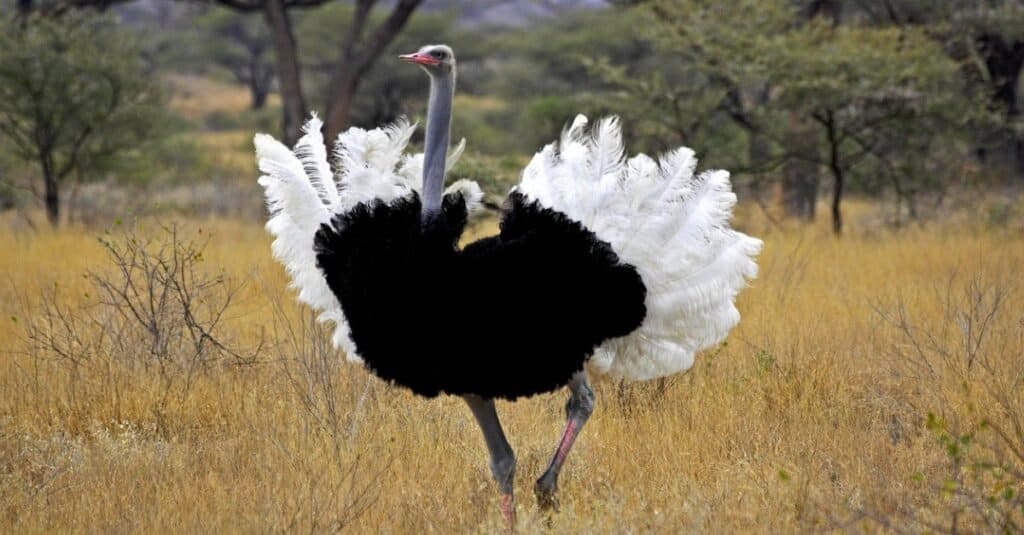
Ostriches use their wing and tail feathers mostly for courtship and communicative displays, and for extra balance when they run.
©iStock.com/slowmotiongli
2. Orchard Oriole (Icterus spurius)
Measuring only 6 to 7 inches long and weighing less than an ounce, orchard orioles are the smallest species of New World blackbirds. Male birds have black feathers on their heads and backs, with rich chestnut-colored feathers on their undersides. Female and juvenile birds, on the other hand, exhibit more subdued olive green feathers on top with yellowish feathers on their bellies. Your best chance to spot one of these beautiful birds is to look along river edges or open woodland areas with scattered trees in the eastern United States or southern Canada.

Orchard orioles have also been known to frequent orchards, parks, and pastures.
©iStock.com/Robert Brown
3. Ovenbird (Seiurus aurocapilla)
The ovenbird gets its name from the nest it builds — a round, dome-like structure. It builds an entrance to the nest on the side, making it look a lot like an old-fashioned oven! Ovenbirds are a type of warbler and often live in leafy woods near the ground. They are secretive birds that lack the vibrant colors of other warbler species. They have olive-brown feathers on their backs, and white bellies decorated with black streaks. Ovenbirds are also migratory. They live in eastern North America during their breeding season but then head down to Central America, northern Venezuela, Florida, and many of the Caribbean islands for the winter.
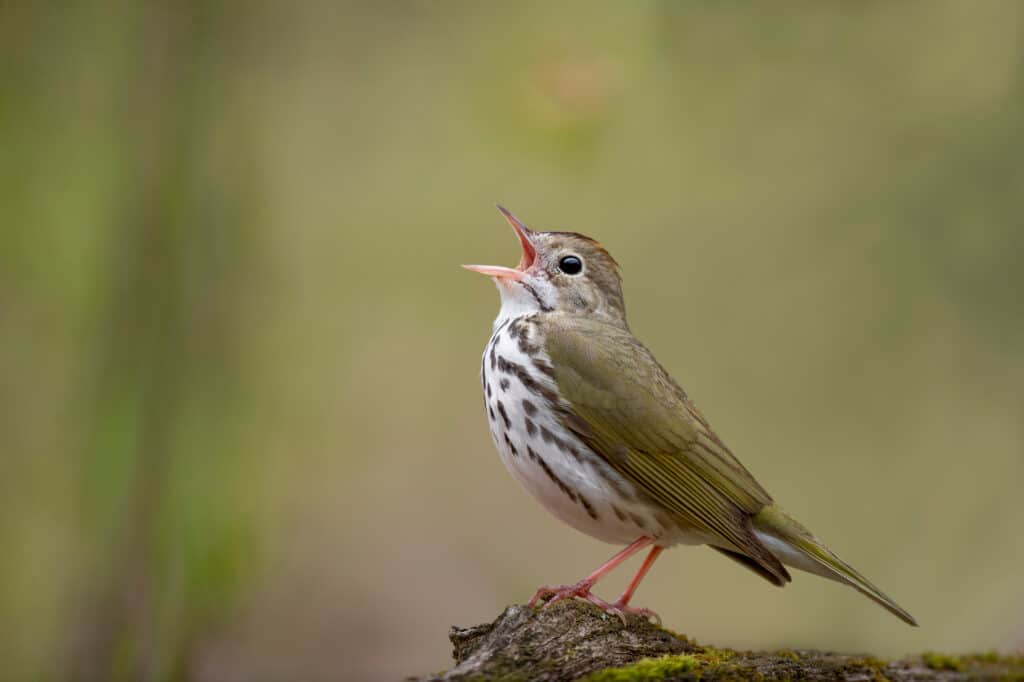
When the ovenbird gets agitated it can raise this stripe to form a crest, and yell down from a high branch, “Tea-cher, tea-cher, tea-cher!
©Ray Hennessy/Shutterstock.com
4. Ocellated Antbird (Phaenostictus mcleannani)
These stunning birds that start with O live in the southern regions of Central America and the northwestern regions of South America. They are about 7.5 inches long, with light brownish-yellow or reddish-brownish chests, gray heads, and black throats. The feathers on their chests and backs are spotted. In addition, the area surrounding each eye is featherless, revealing beautiful, rich blue skin. Ocellated antbirds mostly eat arthropods and insects — especially army ants.

Ocellated antbirds are social and often hang out in small flocks or in pairs in tropical forests and woodlands.
©Gualberto Becerra/Shutterstock.com
5. Oaxaca Sparrow (Aimophila notosticta)
Like its name, the Oaxaca sparrow only lives in Oaxaca (a state in Mexico). This shy little bird is a master of stealth, and often keeps a low profile on or near the ground. Oaxaca sparrows have beautiful faces with striking brown, black, and grayish-white patterns. They are small birds that are only about 5 inches long and feed on spiders, insects, and seeds. Oaxaca sparrows prefer dry forest areas, brushy woodlands, and thorn scrub habitats. Unfortunately, their wild populations are threatened by habitat loss, livestock grazing, hunting, and the introduction of exotic species in their range.
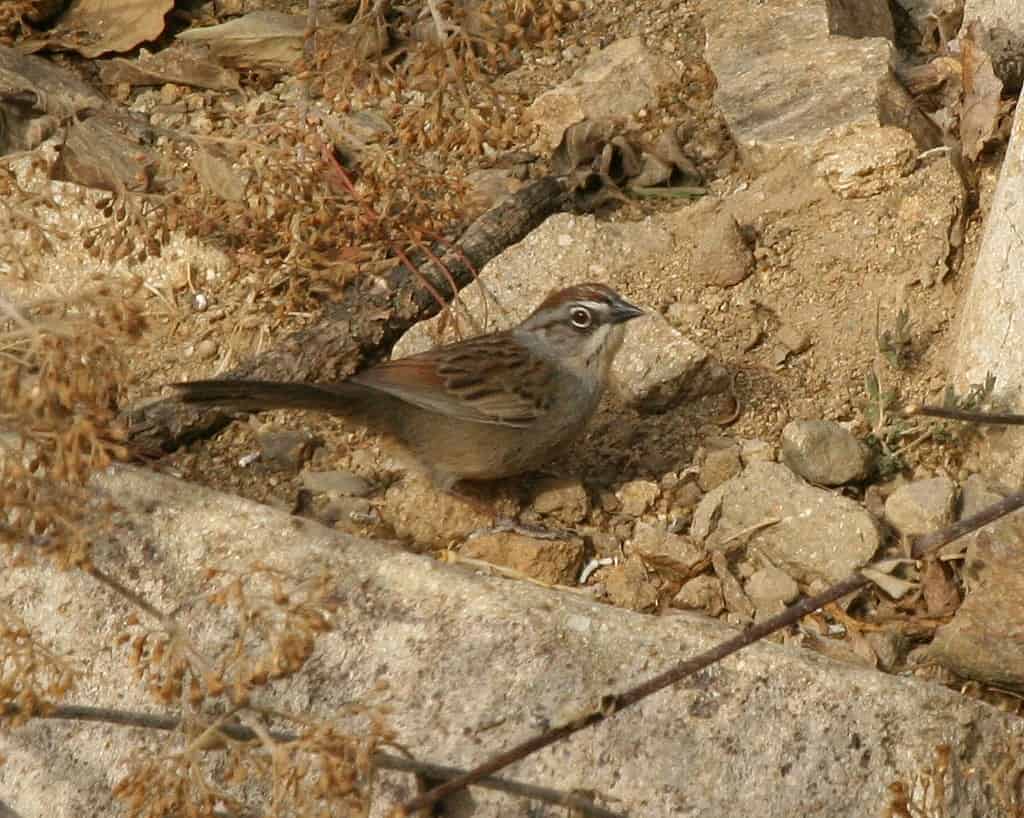
Oaxaca sparrows spend much of the day jumping around on the ground as they look for things to eat.
©dominic sherony / CC BY-SA 2.0 – License
6. Orange Chat (Epthianura aurifrons)
Found only in Australia, the orange chat is a small songbird that forages for berries, seeds, spiders, insects, and other small invertebrates on the ground. It is only 4 to 5 inches long, with long, rounded wings, long legs, and a short tail. Male orange chats have vibrant yellow tinged with orange on their heads and bellies. They have bold and dramatic dark markings on their throats and paler dark markings on their wings. Female orange chats lack these dark markings and have pale yellowish and grayish-mottled feathers instead of orange.
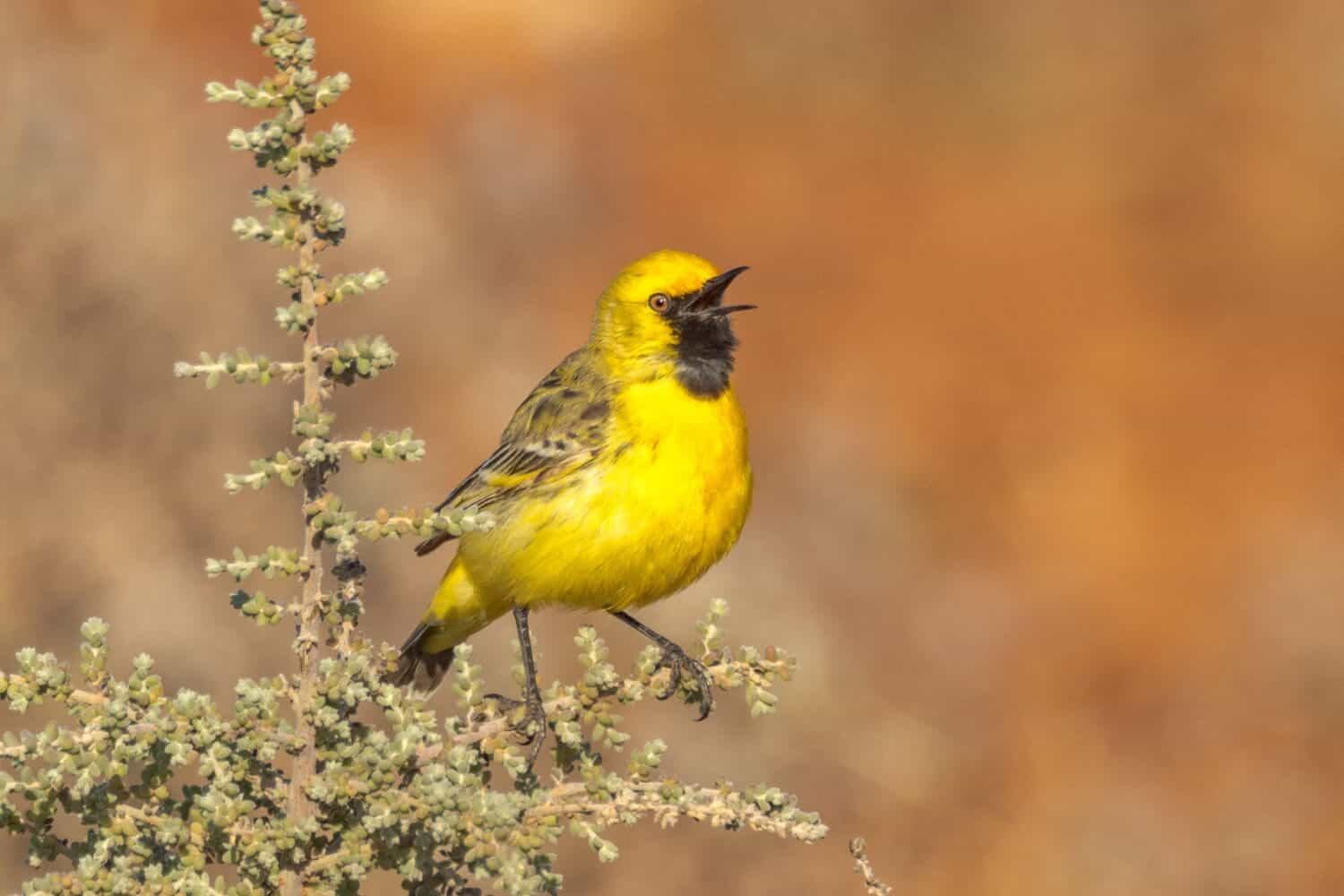
Orange chats are nomadic birds and move depending on available resources like food and water.
©Imogen Warren/Shutterstock.com
7. Osprey (Pandion haliaetus)
Also known as fish hawks, river hawks, and sea hawks, ospreys are large birds of prey that primarily eat fish that they catch from the water. Ospreys are around 24 inches long with brown feathers on their backs and grayish-white feathers on their undersides and heads. They are unique birds that can live in many different kinds of habitats on every continent except for Antarctica.
As piscivores (animals that eat fish), ospreys have many unique adaptations. For example, their toes can move backward or forward, making it easier for them to grab and hold onto slippery fish. In addition, when they dive into the water to catch fish, their nostrils close up like a trapdoor to keep water out.
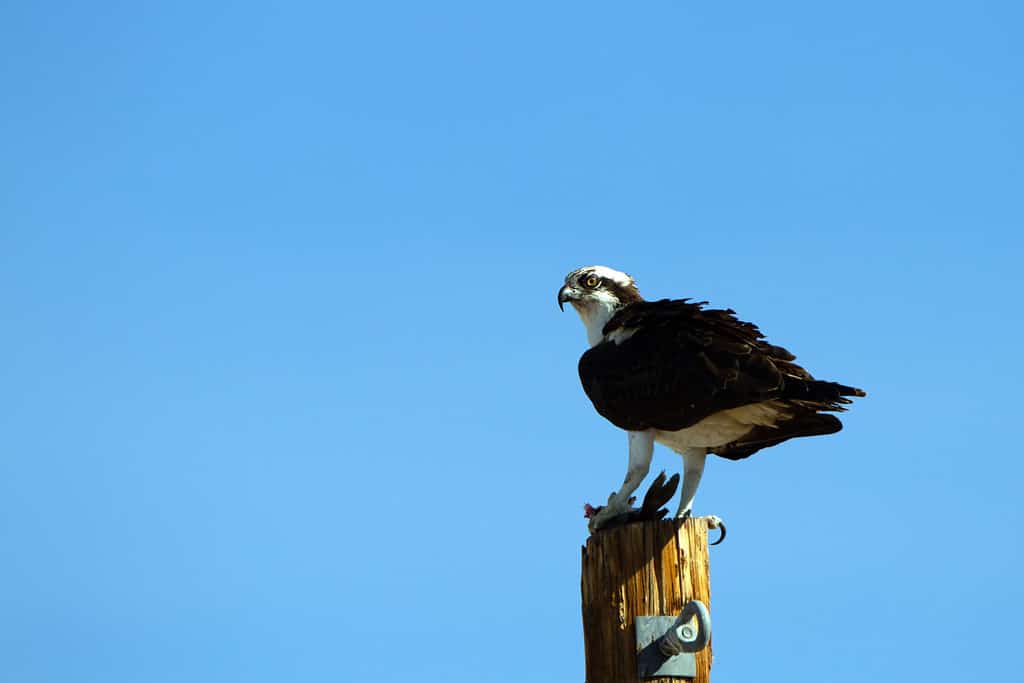
Osprey have sharp textured talons that help them to grip slippery prey like fish.
©Martha Marks/Shutterstock.com
8. Olive Warbler (Peucedramus taeniatus)
The olive warbler is a songbird that likes to nest in the southern parts of New Mexico and Arizona, as well as Mexico down to Nicaragua. These amazing birds that start with O are just 5 to 5.5 inches long. Male birds are mostly gray, with white bars and olive green coloring on their wings. Their chest and head feathers are a light, brownish-orange color, and they have bold black patches around their eyes. Female and juvenile birds have a less prominent black mask on their faces and have yellow feathers rather than orange ones. Olive warblers are shy birds that tend to spend time high up in the tree canopy.
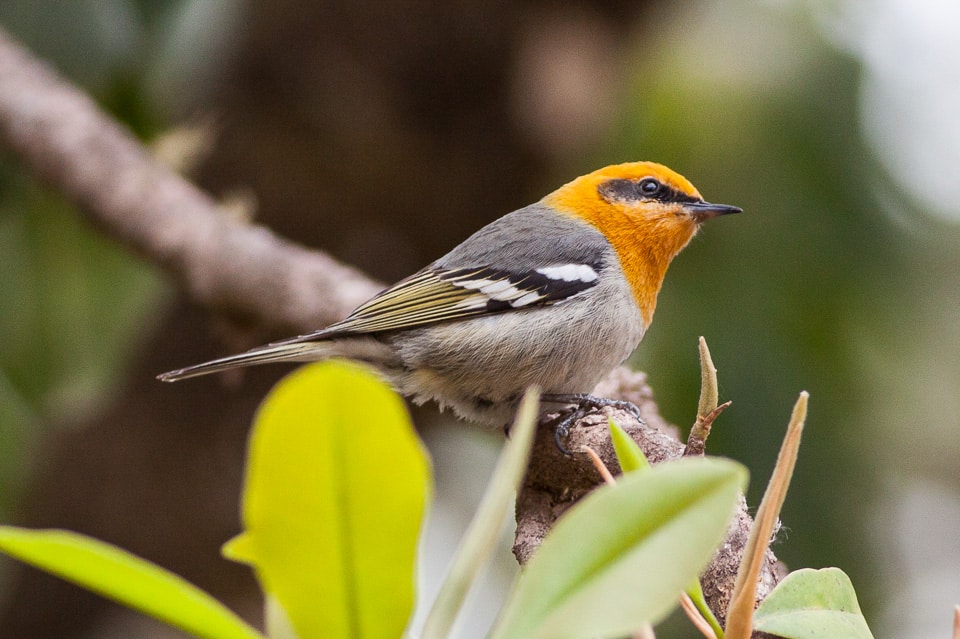
Despite their name, olive warblers aren’t actually warblers!
©Ron Knight / CC BY 2.0 – License
9. Oriental Bay Owl (Phodilus badius)
Found in parts of India and throughout southeast Asia, the Oriental bay owl is a rare bird that is not commonly seen. It is around 8.8 to 11.4 inches long, with an angular head and a unique face shaped like a heart. These owls have striking dark eyes that stand out starkly against the rest of their face. The top and back half of the bird’s body is a beautiful reddish brown or chestnut color, while its underbelly is a creamy tannish hue with tiny spots. Oriental bay owls “hoot” just like other owl species — but they are also excellent mimics and can even imitate bird calls from other species!
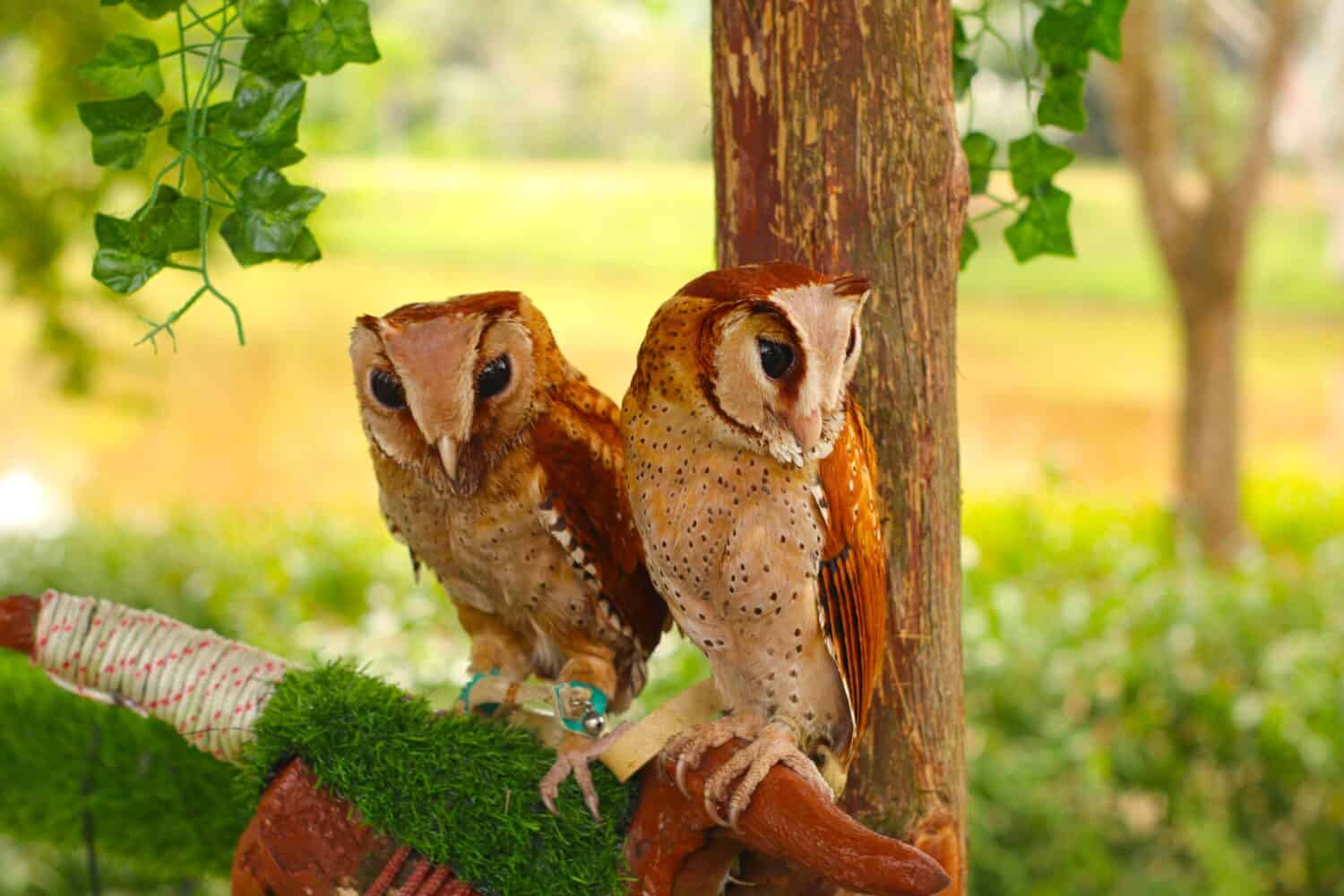
Oriental bay owls are completely nocturnal.
©Hanafi Zul Afkar/Shutterstock.com
10. Oilbird (Steatornis caripensis)
Although it behaves a lot like a bat, the guácharo or oilbird is a very special bird species in the northern regions of South America. Much like bats, oilbirds nest together in caves, and they only come out at night to forage for food. They are fruit-eating birds with powerful, hooked beaks and unique adaptations for nocturnal life. For example, oilbirds have incredible night vision and use echolocation to navigate through the darkness. Their long wings allow greater twisting and hovering while flying, making it much easier to move through the caves where they live.
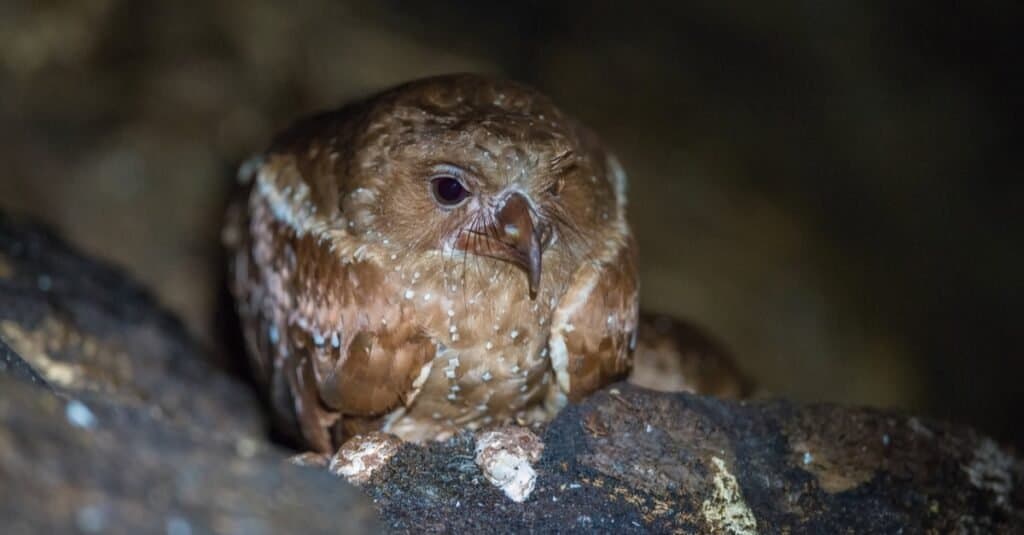
Oilbirds are 16 to 19 inches long, with reddish-brown bodies and white spots on their wings.
©Petr Simon/Shutterstock.com
11. Orange-Bellied Manakin (Lepidothrix suavissima)
The beautiful and vibrant orange-bellied mannequin is a tiny yet striking bird measuring around 3.9 inches in length. Male birds are predominantly black, with a vividly contrasting bright yellow belly. Their foreheads dazzle with snowy white feathers, and the feathers on their rumps are a graceful sky-blue color. In contrast, females and juvenile birds have brilliant green feathers on top of their bodies, blue on the top of their heads, and soft yellow feathers on their undersides. Orange-bellied manakins live in central Guyana, the far-north regions of Brazil, and southern Venezuela.
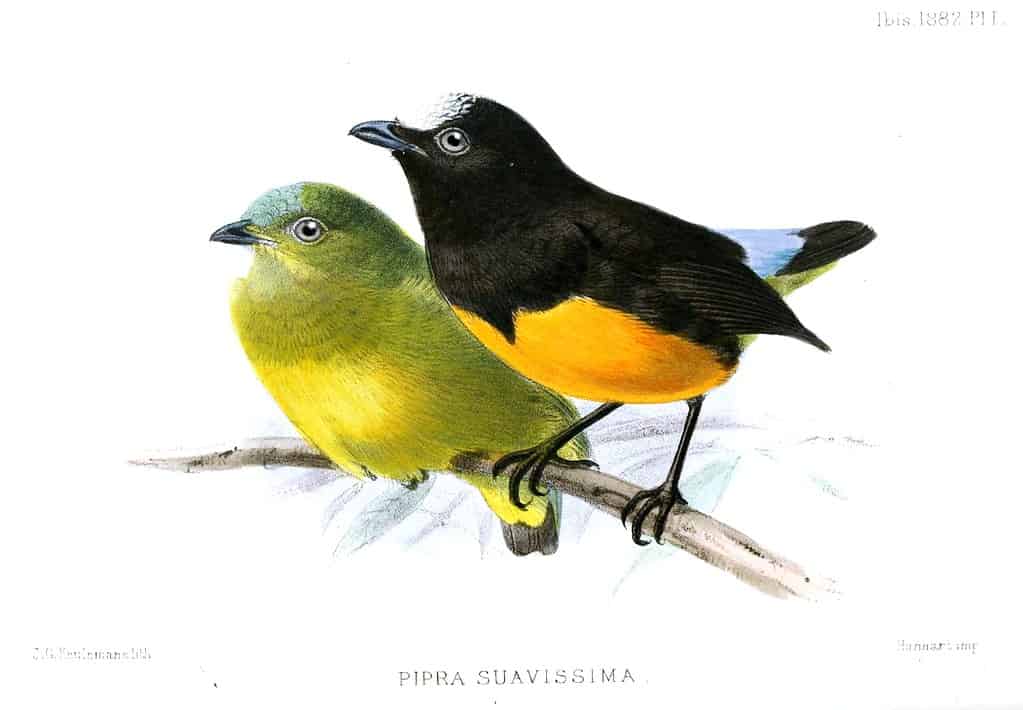
Orange-bellied manakins make their homes in the forests atop tepuis (the table-top mountains in their home ranges).
©John Gerrard Keulemans / PD-US – License
12. Okarito Kiwi (Apteryx rowi)
Also known as the Okarito brown kiwi or the rowi, the Okarito kiwi only lives on the West Coast of New Zealand’s South Island in the Ōkārito forest. These charming little birds have large, round bodies, long bills, and short legs, giving them their own very unique appearance in the bird world. They have soft and luscious brown feathers streaked with shades of black and brown. Okarito kiwis use their long bills to dig for worms, insects, and other invertebrates in the soil. They are nocturnal birds and cannot fly. Unfortunately, because their range is so small, and due to the threat of imported animals and habitat loss, the Okarito kiwi is classified as a vulnerable species. There are only around 600 birds in the wild.

Okarito kiwis sniff loudly and tap their feet on the ground to stir up and find bugs to eat.
©iStock.com/Liu Yang
13. Oystercatcher (Haematopus)
Ranging from 15.5 to 19.5 inches long, oystercatchers are hard to miss. They are vocal and social birds, making themselves known with their noisy calls as they congregate in groups along the shore. You can spot these striking birds on many coastal shores all over the world. Oystercatchers have black or dark brown feathers on top of their bodies, which contrasts sharply with the white feathers on their undersides. However, it’s their massive, vibrant red or orange bills that really steal the show.
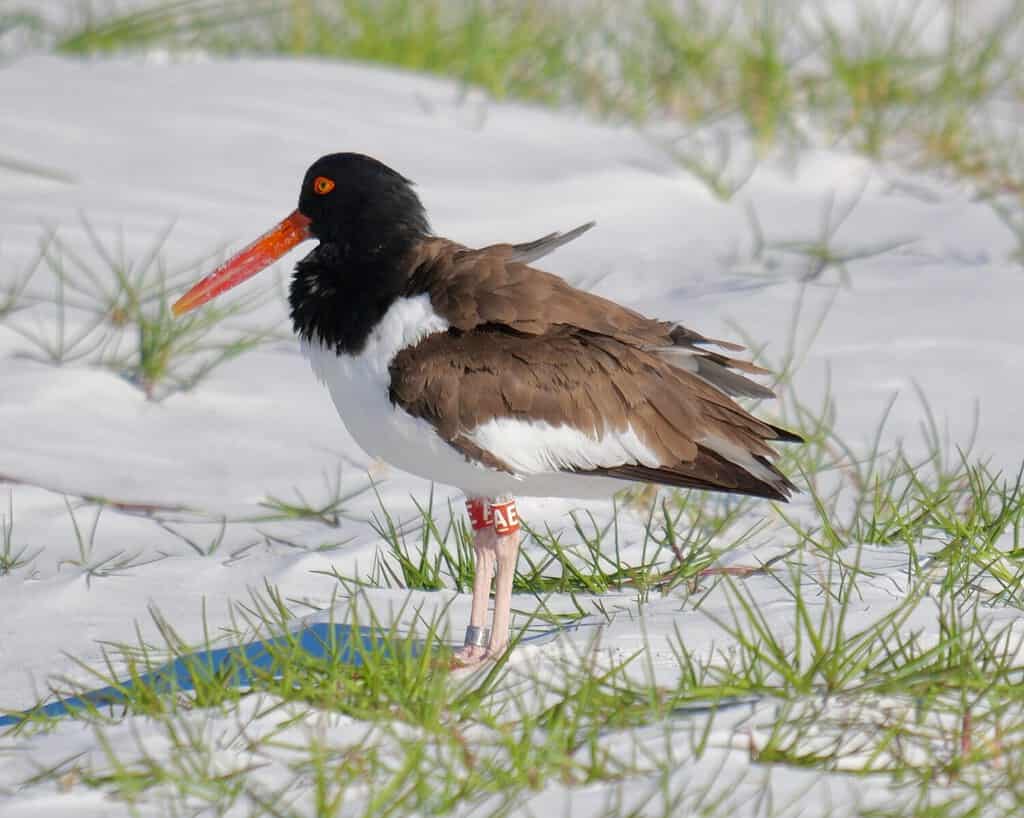
Oystercatchers have powerful beaks that are perfectly adapted for prying open or smashing mollusks.
©Archaeopteryx Tours/Shutterstock.com
14. Orangequit (Euneornis campestris)
Orangequit birds live only in Jamaica, where they make their homes in tropical or subtropical forests. Males are particularly striking with their beautiful and mesmerizing grayish-blue bodies. Their short, pointed bills curve down in an elegant arc, and there is a vibrant orange patch of feathers on their throats. Female orangequits, on the other hand, have olive-gray to warm brown colored feathers, and their heads are a subtle gray color.
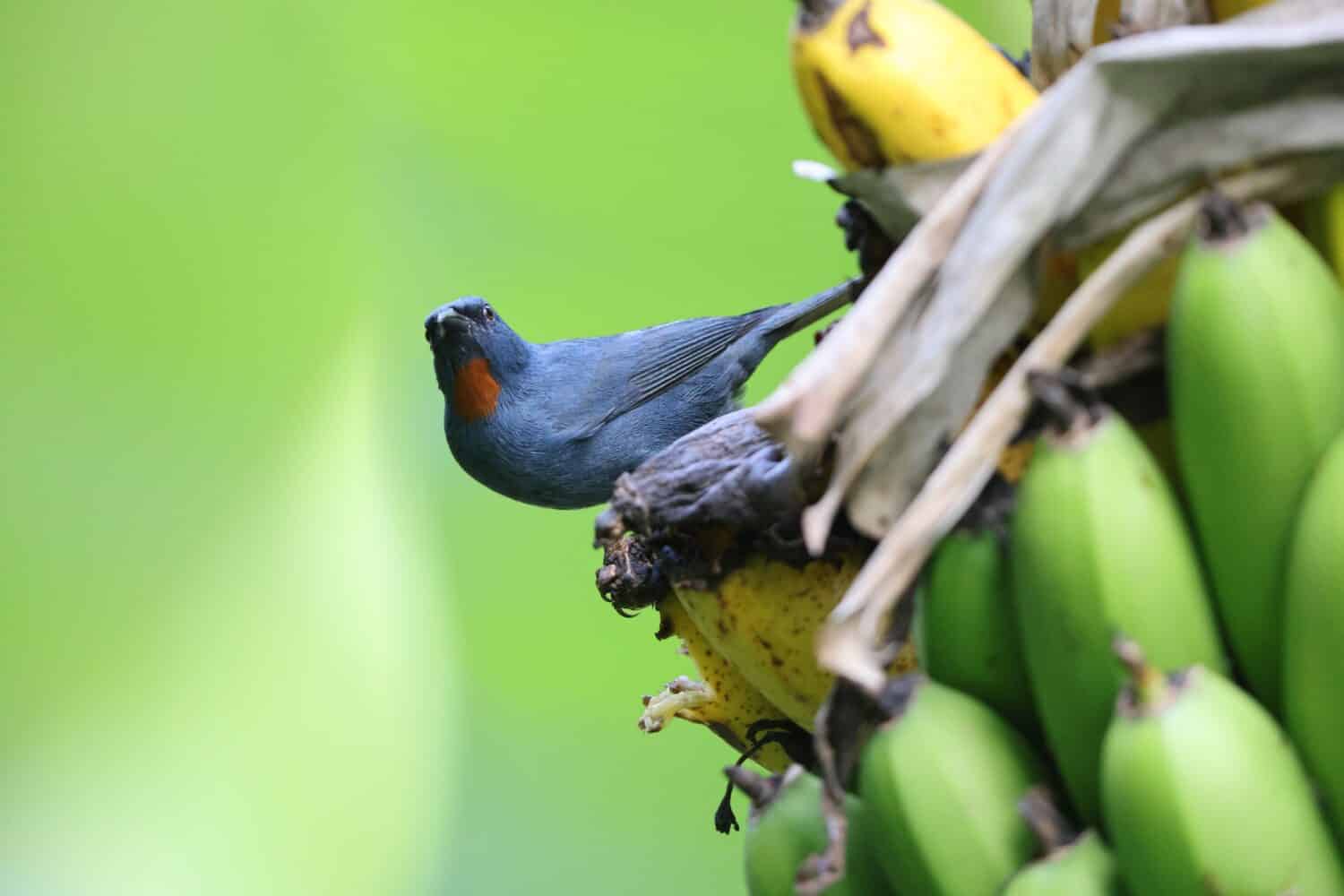
Orangequits skillfully hide their nests high in the canopy, usually almost 20 feet off the ground.
©feathercollector/Shutterstock.com
15. Oriental Scops-Owl (Otus sunia)
Another amazing bird that starts with O is the Oriental scops-owl, found in southern and eastern Asia. This little owl has striking yellow eyes and two cute ear tuffs that can either stand straight up or lay flat depending on its mood. It has a white stripe on its back, well-marked underparts, and gray or reddish-brown feathers — and sometimes a captivating mixture of both! When Oriental scops-owls feel shy or scared, they sometimes freeze with their eyes half open, half closed. These beautiful owls are generalists, which means that they eat a wide variety of different things, from birds and small mammals to insects and spiders.
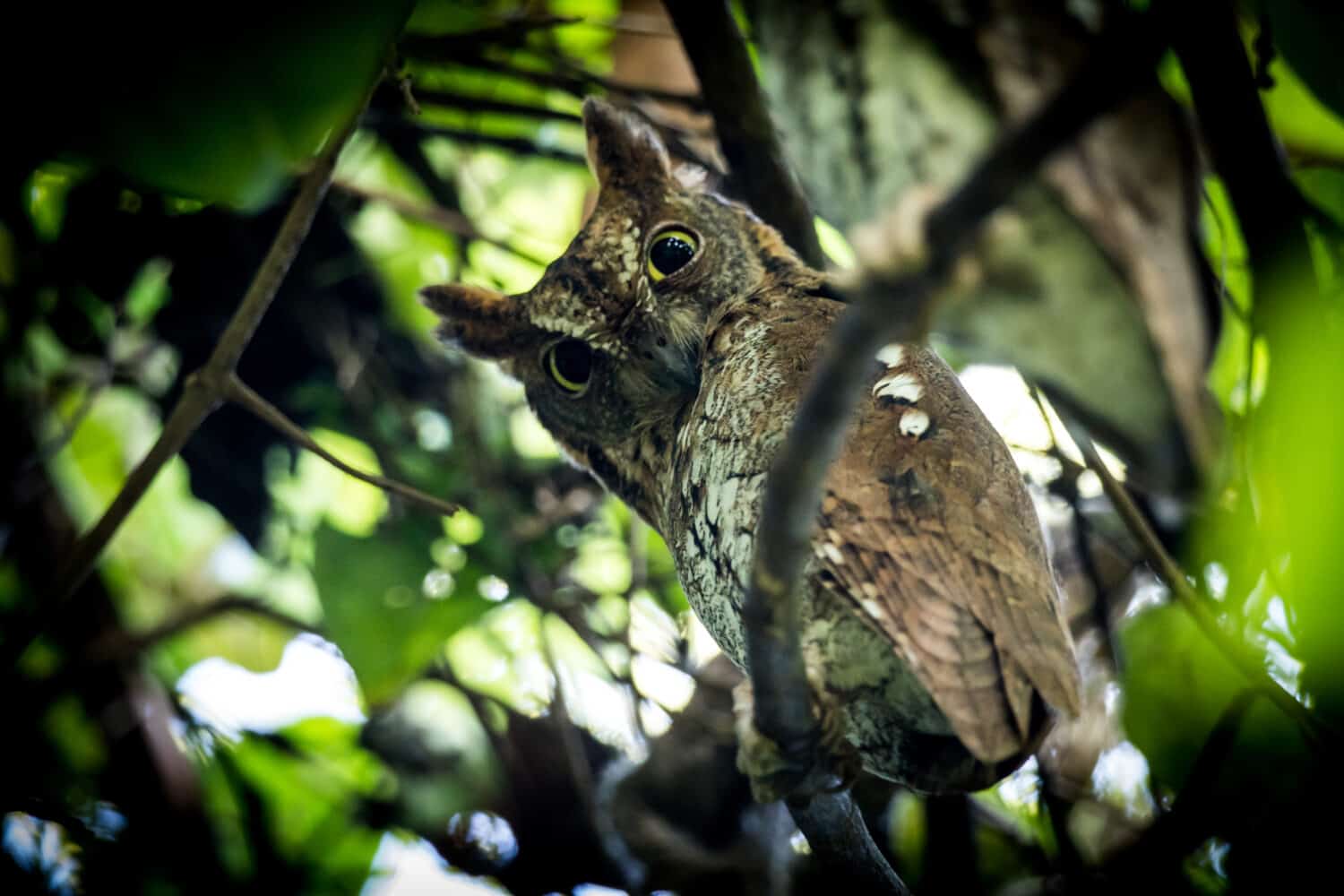
Oriental scops-owls live in areas like gardens, forests, and parks.
©wonderisland/Shutterstock.com
16. Orange-Backed Woodpecker (Reinwardtipicus validus)
The orange-backed woodpecker stands out from all other crested woodpeckers with its eye-catching patchwork of colors. Male birds have a reddish-colored crest atop their regal heads and fiery orange breasts. Their backs are a warm, creamy color, and their wings are a beautiful mosaic of dark brown and orange patterns and white wingbars. Orange-backed woodpeckers live in Malaya, southern Thailand, Sabah and Sarawak in Malaysia, Sumatra, Brunei, and Java.
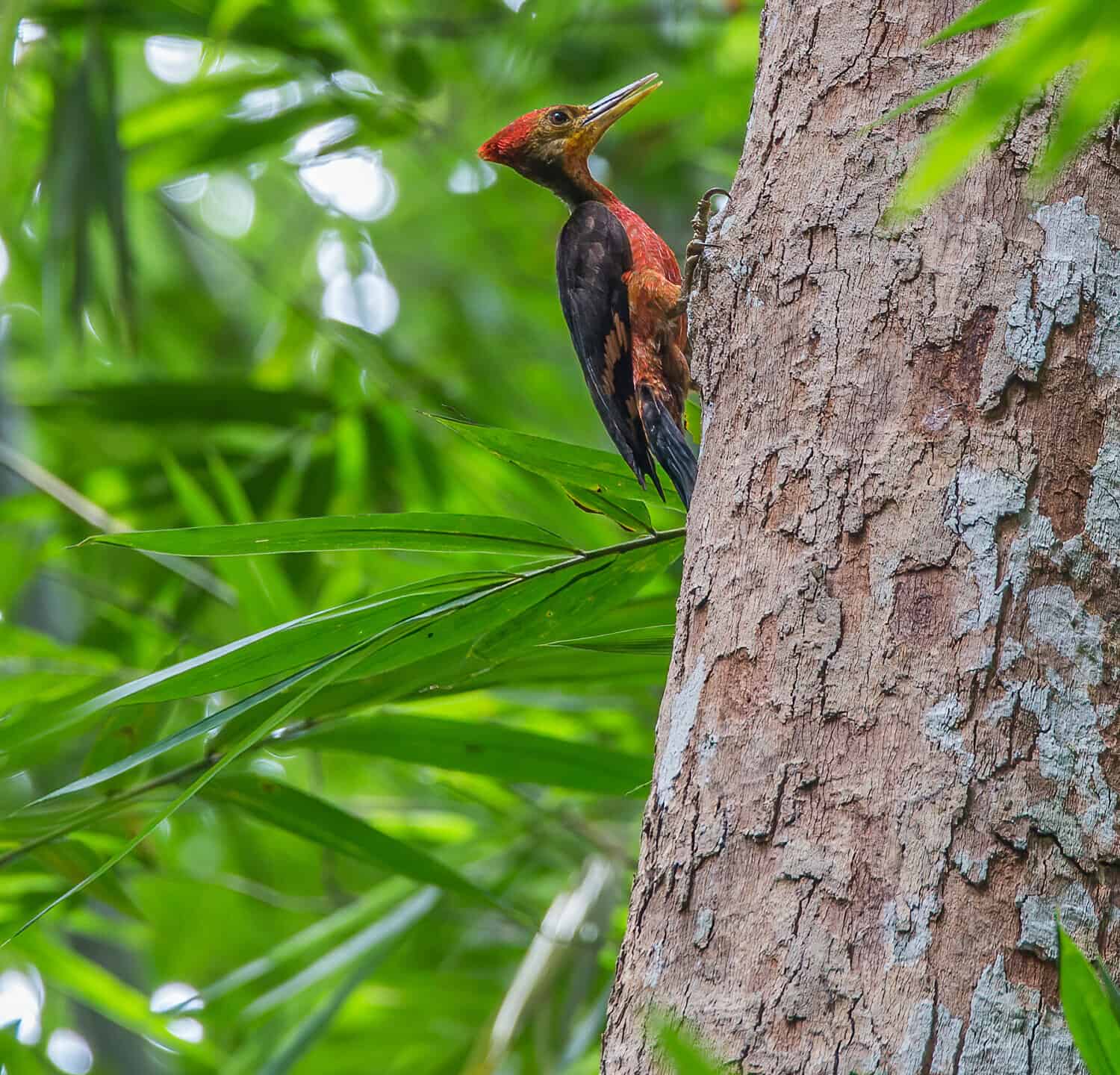
Orange-backed woodpeckers are very vocal birds with unique calls.
©ZakiFF/Shutterstock.com
17. Okinawa Rail (Gallirallus okinawae)
These amazing birds that start with O only live on Japan’s Okinawa Island, in and near tropical or moist forest habitats. They aren’t very good at flying, but they are great runners. Okinawa rails spend much of their time foraging on the ground, but they do build their nests in trees. They are beautiful birds with bright orange-red bills and legs, a bold contrast against their darker-colored bodies. Their feathers are dark brown and black, with thin white striping on their chests and a bold white streak running behind their eyes. Unfortunately, the Okinawa rail is an endangered species that is struggling against introduced predators and habitat loss.

Okinawa rails appear to be monogamous birds who mate for life.
©feathercollector/Shutterstock.com
18. Olivaceous Woodcreeper (Sittasomus griseicapillus)
Although it is a somewhat common bird, the olivaceous woodcreeper is difficult to spot. These inconspicuous birds move quickly and blend in well with their surroundings. Their slender bodies are about 5 to 7.5 inches long, with gray and reddish-brown feathers and no patterns, spots, or streaks. Olivaceous woodcreepers live in Central Mexico, Central America, Tobago, and much of South America. Their name comes from their unique habit of “creeping” or climbing along tree trunks as they search for food.

Olivaceous woodcreepers use their long and pointed bills to dig and feel for insects and other small invertebrates.
©Leonardo Mercon/Shutterstock.com
19. Orange Oriole (Icterus auratus)
The vibrant colors of the orange oriole grace the skies of the Yucatán Peninsula and the far north of Belize. It is a stunning avian species that thrives in tropical and subtropical dry forests. Orange orioles are around 6.3 inches long, with dazzling colors and patterns. Male birds are a bright tangerine-like orange, with yellow backs and black and white patterns on their wings. They also have a black mask that trails down their chests like a little bib. Female birds lack the black mask and bib and instead have grayish streaks on their heads and backs. Their wings are much like the males, but their overall color is more yellow-orange. Orange orioles are playful birds that sometimes hang upside down while they munch on nectar, fruit, and insects.
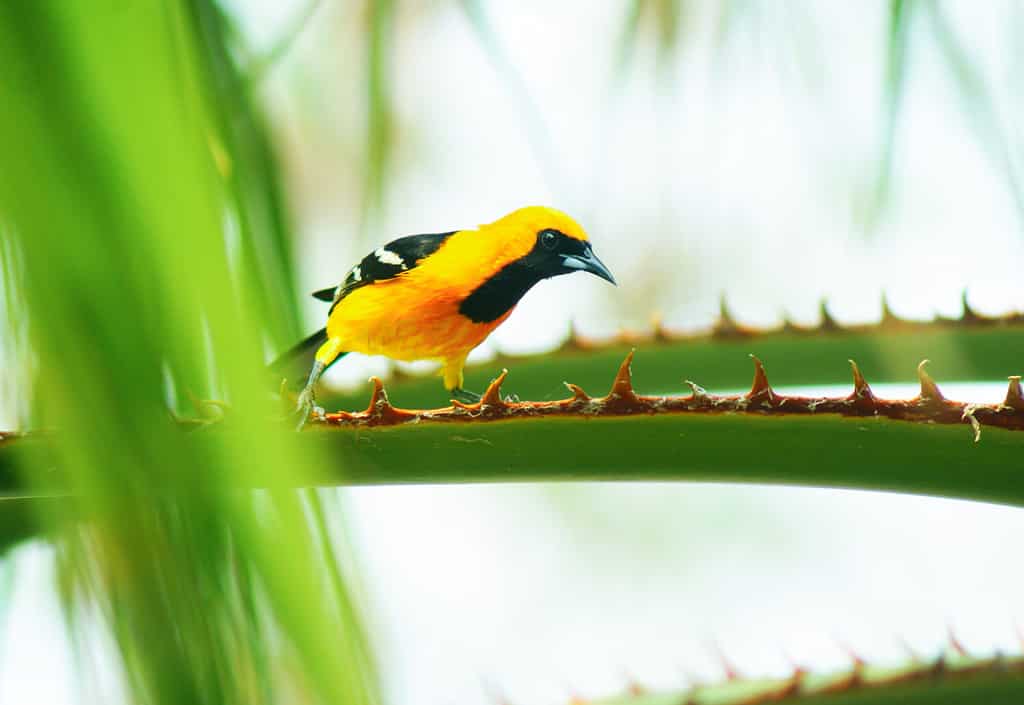
Orange orioles are vocal birds and love to sing.
©Javier Correa/Shutterstock.com
20. Olivaceous Piculet (Picumnus olivaceus)
A member of the woodpecker family, the olivaceous piculet lives from Guatemala down to Central America and the western regions of South America to Peru. These tiny woodpeckers are just 3.3 to 3.9 inches long with olive-brown feathers. They also have darker feathers and tiny white spots on the top of their heads. Olivaceous piculets sometimes like to hang upside down, and often hang out around gardens and forested areas.

Male and female olivaceous piculets have a similar appearance, although males often have an orangish-colored patch on top of their heads.
©Milan Zygmunt/Shutterstock.com
21. Oak Titmouse (Baeolophus inornatus)
The oak titmouse sports gray-brown plumage with a slightly lighter underside and no distinctive markings. It is a small songbird around 5 inches long that lives in the western regions of the United States and Mexico. Oak titmice mate for life and are very defensive of their territory. Although they aren’t the most colorful birds, oak titmice have beautiful and bright personalities. They are social birds that love to sing loudly with others.

Oak titmice are acrobatic and energetic birds, and sometimes even hang upside down while they eat.
©J. S. Fisher/Shutterstock.com
The Largest Bird That Starts With O
The ostrich is the largest bird that starts with O. These incredibly large birds can grow up to 9 feet tall and weigh up to 300 pounds! Because of their enormous size and weight, ostriches can’t fly, but they are incredible runners. In fact, a single stride for an ostrich can be 10 to 16 feet long! And it’s not just the adult bird that’s so big — ostrich eggs are just as impressive, measuring 6 inches long and 5 inches wide, and weighing 3.1 pounds!

Ostriches are the largest birds on earth today, and their eggs are the largest bird eggs too!
©Dominique de La Croix/Shutterstock.com
The Fastest Bird That Starts With O
Ostriches aren’t just big, but they are also fast — in fact, they are the fastest birds that run on land, reaching sprinting speeds of up to 43 miles per hour! However, in the skies, the fastest-flying bird that starts with O is the osprey. In their normal, everyday flight, ospreys can soar through the skies at 31 miles per hour. However, when diving — as they do when they catch fish — ospreys can go even faster, reaching speeds of up to 78 miles per hour!

Ospreys have excellent vision and can detect underwater objects from the air.
©BlueBarronPhoto/Shutterstock.com
Summary of Amazing Birds That Start With O
| Common Name | Scientific Name |
|---|---|
| Ostrich | Struthio camelus |
| Orchard Oriole | Icterus spurius |
| Ovenbird | Seiurus aurocapilla |
| Ocellated Antbird | Phaenostictus mcleannani |
| Oaxaca Sparrow | Aimophila notosticta |
| Orange Chat | Epthianura aurifrons |
| Osprey | Pandion haliaetus |
| Olive Warbler | Peucedramus taeniatus |
| Oriental Bay Owl | Phodilus badius |
| Oilbird | Steatornis caripensis |
| Orange-Bellied Manakin | Lepidothrix suavissima |
| Okarito Kiwi | Apteryx rowi |
| Oystercatcher | Haematopus |
| Orangequit | Euneornis campestris |
| Oriental Scops-Owl | Otus sunia |
| Orange-Backed Woodpecker | Reinwardtipicus validus |
| Okinawa Rail | Gallirallus okinawae |
| Olivaceous Woodcreeper | Sittasomus griseicapillus |
| Orange Oriole | Icterus auratus |
| Olivaceous Piculet | Picumnus olivaceus |
| Oak Titmouse | Baeolophus inornatus |
The photo featured at the top of this post is © Gualberto Becerra/Shutterstock.com
Thank you for reading! Have some feedback for us? Contact the AZ Animals editorial team.






